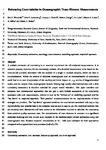Estimating Uncertainties in Oceanographic Trace Element Measurements
| dc.contributor.author | Worsfold, Paul | |
| dc.contributor.author | Achterberg, E | |
| dc.contributor.author | Birchill, A | |
| dc.contributor.author | Clough, Robert | |
| dc.contributor.author | Leito, I | |
| dc.contributor.author | Lohan, M | |
| dc.contributor.author | Milne, Angela | |
| dc.contributor.author | Ussher, Simon | |
| dc.date.accessioned | 2019-02-27T10:02:39Z | |
| dc.date.issued | 2019-01-21 | |
| dc.identifier.issn | 2296-7745 | |
| dc.identifier.issn | 2296-7745 | |
| dc.identifier.other | ARTN 515 | |
| dc.identifier.uri | http://hdl.handle.net/10026.1/13360 | |
| dc.description.abstract |
A realistic estimation of uncertainty is an essential requirement for all analytical measurements. It is common practice, however, for the uncertainty estimate of a chemical measurement to be based on the instrumental precision associated with the analysis of a single or multiple samples, which can lead to underestimation. Within the context of chemical oceanography such an underestimation of uncertainty could lead to an over interpretation of the result(s) and hence impact on, e.g., studies of biogeochemical cycles, and the outputs from oceanographic models. Getting high quality observational data with a firm uncertainty assessment is therefore essential for proper model validation. This paper describes and compares two recommended approaches that can give a more holistic assessment of the uncertainty associated with such measurements, referred to here as the "bottom up" or modeling approach and the "top down" or empirical approach. "Best practice" recommendations for the implementation of these strategies are provided. The "bottom up" approach combines the standard uncertainties associated with each stage of the entire measurement procedure. The "top down" approach combines the uncertainties associated with day to day reproducibility and possible bias in the complete data set and is easy to use. For analytical methods that are routinely used, laboratories will have access to the information required to calculate the uncertainty from archived quality assurance data. The determination of trace elements in seawater is a significant analytical challenge and iron is used as an example for the implementation of both approaches using real oceanographic data. Relative expanded uncertainties of 10-20% were estimated for both approaches compared with a typical short term precision (rsd) of ≤5%. | |
| dc.format.extent | 515- | |
| dc.language.iso | en | |
| dc.publisher | Frontiers Media | |
| dc.subject | uncertainty estimation | |
| dc.subject | metrology | |
| dc.subject | trace elements | |
| dc.subject | modeling approach | |
| dc.subject | empirical approach | |
| dc.title | Estimating Uncertainties in Oceanographic Trace Element Measurements | |
| dc.type | journal-article | |
| dc.type | Review | |
| dc.type | Journal | |
| plymouth.author-url | https://www.webofscience.com/api/gateway?GWVersion=2&SrcApp=PARTNER_APP&SrcAuth=LinksAMR&KeyUT=WOS:000587335300001&DestLinkType=FullRecord&DestApp=ALL_WOS&UsrCustomerID=11bb513d99f797142bcfeffcc58ea008 | |
| plymouth.issue | JAN | |
| plymouth.volume | 5 | |
| plymouth.publication-status | Published online | |
| plymouth.journal | Frontiers in Marine Science | |
| dc.identifier.doi | 10.3389/fmars.2018.00515 | |
| plymouth.organisational-group | /Plymouth | |
| plymouth.organisational-group | /Plymouth/Faculty of Science and Engineering | |
| plymouth.organisational-group | /Plymouth/Faculty of Science and Engineering/School of Geography, Earth and Environmental Sciences | |
| plymouth.organisational-group | /Plymouth/REF 2021 Researchers by UoA | |
| plymouth.organisational-group | /Plymouth/REF 2021 Researchers by UoA/UoA07 Earth Systems and Environmental Sciences | |
| plymouth.organisational-group | /Plymouth/Research Groups | |
| plymouth.organisational-group | /Plymouth/Research Groups/BEACh | |
| plymouth.organisational-group | /Plymouth/Research Groups/Marine Institute | |
| plymouth.organisational-group | /Plymouth/Users by role | |
| plymouth.organisational-group | /Plymouth/Users by role/Academics | |
| plymouth.organisational-group | /Plymouth/Users by role/Researchers in ResearchFish submission | |
| dcterms.dateAccepted | 2018-12-21 | |
| dc.rights.embargodate | 2019-3-12 | |
| dc.identifier.eissn | 2296-7745 | |
| dc.rights.embargoperiod | Not known | |
| rioxxterms.funder | Natural Environment Research Council | |
| rioxxterms.identifier.project | Carbon Uptake and Seasonal Traits in Antarctic Remineralisation Depth (CUSTARD) | |
| rioxxterms.versionofrecord | 10.3389/fmars.2018.00515 | |
| rioxxterms.licenseref.uri | http://www.rioxx.net/licenses/all-rights-reserved | |
| rioxxterms.licenseref.startdate | 2019-01-21 | |
| rioxxterms.type | Journal Article/Review | |
| plymouth.funder | Carbon Uptake and Seasonal Traits in Antarctic Remineralisation Depth (CUSTARD)::Natural Environment Research Council | |
| plymouth.funder | Carbon Uptake and Seasonal Traits in Antarctic Remineralisation Depth (CUSTARD)::Natural Environment Research Council | |
| plymouth.funder | Carbon Uptake and Seasonal Traits in Antarctic Remineralisation Depth (CUSTARD)::Natural Environment Research Council | |
| plymouth.funder | Carbon Uptake and Seasonal Traits in Antarctic Remineralisation Depth (CUSTARD)::Natural Environment Research Council |


